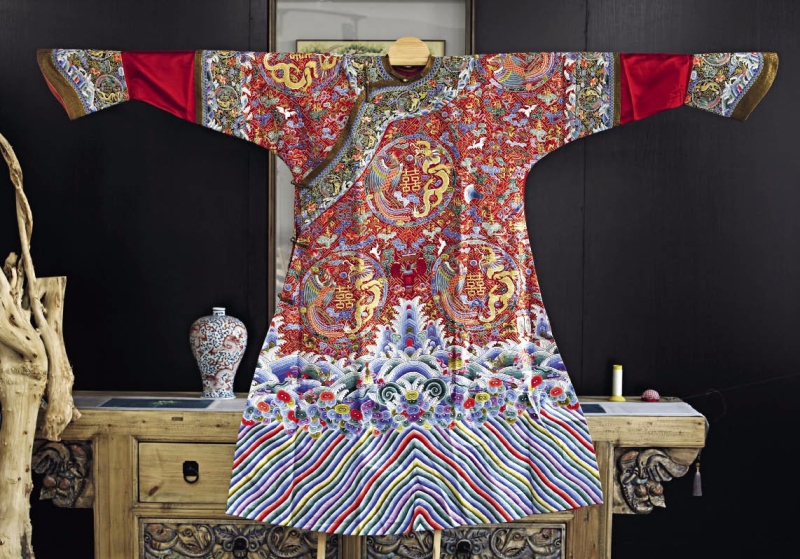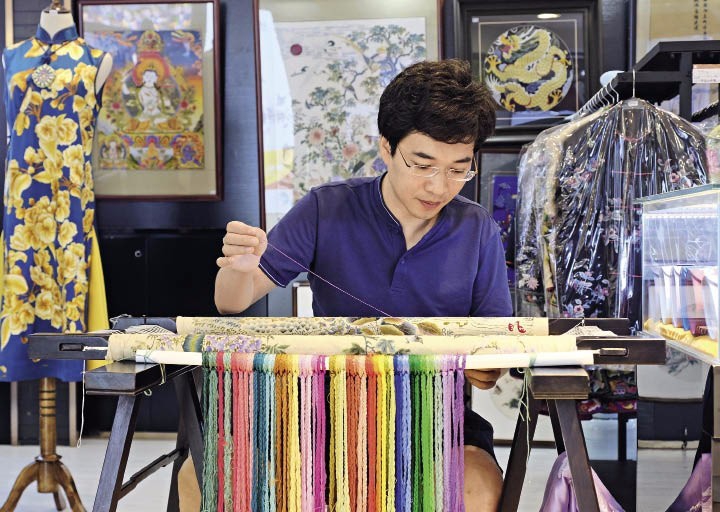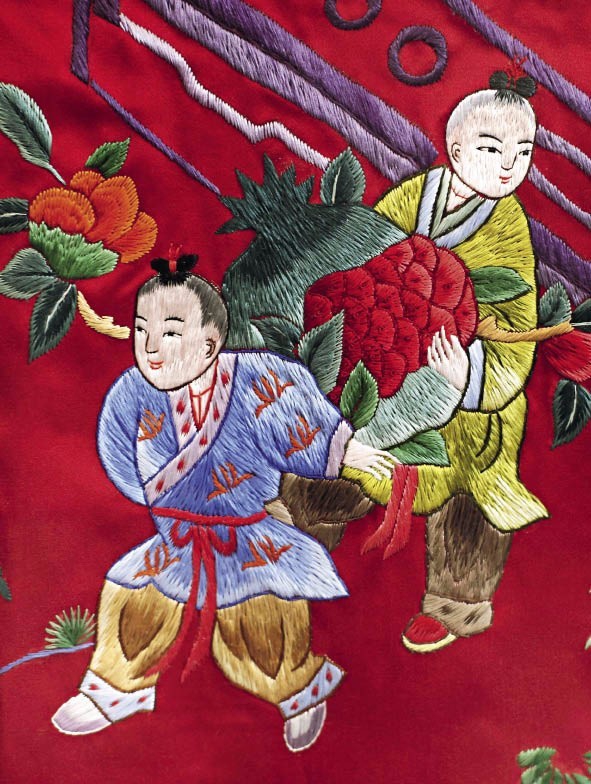
Modern replica of an imperial robe worn by royalty at weddings in the Qing Dynasty.
Beijing embroidery, or jingxiu, is the general term that refers to the style of embroidery products made in the Beijing region, having distinctive regional features. The style of Beijing embroidery traces its beginnings to the palace, for which it also earned the name “palace embroidery.” The art reached its peak during the Ming and Qing dynasties (1368-1911). The exquisite and graceful style of palace embroidery is a unique form of Chinese embroidery, garnering it very high appreciation and value for collectors. In 2014, Beijing embroidery was added to the list of the fourth batch of national intangible culture heritage.
Born in the Palace
Ancient embroidery styles from the Beijing region originally consisted of boudoir embroidery and palace embroidery. As the name “boudoir” implies, boudoir embroidery was a form of folk embroidery that was done by women at home. Palace embroidery, on the other hand, was solely dedicated to decorating the palace, the emperor, and the marquise. The regional palace embroidery started at the embroidery house in Yanjing, the then name for Beijing, of the Liao Dynasty (916-1125). Later during the Ming Dynasty (1368-1644), the special features of palace embroidery including stitching techniques, use of material, and designs became more distinct, due to which the number of embroidery workers continued to grow rapidly. The Qing Dynasty (1644–1911) was the golden age of palace embroidery in which it grew in popularity and the unique techniques of palace embroidery became more widely used among folk artists in Beijing. Toward the declining years of the Qing Dynasty, there emerged many embroidery shops in Beijing, passing on many of the stitching techniques of palace embroidery, at which point it incorporated more folk and everyday life inspired themes. From then on, the two styles of boudoir embroidery and palace embroidery merged together, forming what then became to be recognized as the unique style of Beijing embroidery.
In an interview, a fifth generation successor of Beijing embroidery, Tian Peng, stated that because Beijing embroidery was made specifically for the palace, it features very fine material, luxurious textures, exquisite designs, dignified and aesthetic patterns, and elegant colors. It is quite decorative in nature, has a variety of techniques, and exemplifies superb craftsmanship, all of which represent the regional culture of Beijing.
The themes of Beijing embroidery mostly reflect traditional Chinese culture, holding to the principles that all images have symbolic meaning and all patterns denote auspiciousness. Being landscape, flowers, fowls, roaming beasts, or lucky symbols of Buddhism, all themes have an auspicious implied meaning.
For example, the making of the 12-symbol imperial robe by Beijing embroidery followed strict rules. The 12 imperial ornamental designs were the ranking marks on dresses in imperial China, and only the emperor could wear them. They included the sun, moon, stars, mountain ranges, dragons, a golden pheasant, and so on. Though the 12 imperial symbols varied to some extent in different dynasties, the implied auspicious meaning was the same. Each ornate element represented an aspect of the reign of the emperor as well as the ideals they were pursuing. The sun, moon, and stars, for example, represent ambition, golden pheasants represent literary talent, nine dragons represent the lucky numbers of the emperor’s supremacy, and wave designs represent complete unification.

Tian Peng, the fifth successor of Beijing embroidery.
“Using symbols to express the desire of the emperor required that the design have aesthetic taste, and the pattern be neat and orderly, so as to exhibit the strong sense of royalty. This is the most unique characteristic of Beijing embroidery,” said Tian Peng.
In addition to the auspicious meaning, the design of Beijing embroidery showed the identification and social status of the person wearing the robe, which is especially true of the robes made in the Qing Dynasty, during which the details of the design and colors of apparel were very standardized.
Take for example the square embroidered design which adorned the front and back of official robes, the fowls that were embroidered on the civil officials’ robes represented literary talent, while the roaming animals which adorned the military officials’ robes represented their bravery. The designs on the robe were also divided into nine different ranks, representing the level of each official’s position. The robe of the first ranking civil official was adorned with a red-crowned crane, while that of the first ranking military official was a qilin, an imaginary auspicious animal similar to Chinese dragon. Each design of fowls and animals was a gorgeous piece of ornate embroidery that exhibited the status of the person wearing it.
The main colors seen in Beijing embroidery include green, yellow, red, blue, and purple, each of which held specific implied meaning. Yellow, for example, represented power, and consequently was only worn by the emperor and the royal family. Red represented celebration, blue represented nobility, and the color worn mostly by imperial court officials was blue. The layout of Beijing embroidery was also different from the simple elegant designs of embroidery in southern China, exhibiting a decorative style that was quite strong, dignified, graceful, and noble.
The overall standard of Beijing embroidery was based on the aesthetics of the court, exhibiting orderly layouts, a wide variety of designs, significant implied meaning, strict requirements for materials, luxurious textures, a dignified and aesthetic appearance, and the distinct regional features of northern China.
A Family of Beijing Embroidery
Tian Peng was born into a family that specialized in Beijing embroidery making. The paternal grandfather of his maternal grandfather once worked in the “Embroidery Bureau” of the Forbidden City during the Qing Dynasty, embroidering imperial robes for the emperor. According to Tian, workers who did embroidery in the palace in ancient times were all males, and the tradition at the time was that the skill was only passed on to the male members of the family. The reason for this was that people feared that the knowledge of the craft would leave the confines of their family when their daughter was married off.
Tian’s maternal grandfather originally planned to pass on the craft to Tian’s two uncles, but with his mother’s fascination with the craft from early childhood, she learned how to do the intricate embroidery all by herself. It was that fascination and determination of Tian’s mother, Liang Shuping, that broke the long tradition of passing on the skills only to male members of the family, and she became the successor of the family handcraft.
In 2000, the Palace Museum asked Liang Shuping to make replicas of the embroidery for the Palace of Earthly Tranquility. The palace was the residency of the queen during the Ming Dynasty, but was later transformed into a place for offering major sacrifices and the bridal chamber of the grand weddings of Qing Dynasty emperors. Liang Shuping, with the help of a team of workers, spent three whole years finishing the replicas of the various items used in the emperors’ grand wedding. The replicas are now on display at the Palace of Earthly Tranquility to help visitors better understand what life was like inside the palace during the Qing Dynasty. The reason it took three years to complete the embroidery work of the replicas was because the style of Beijing embroidery is very detailed. Completing an area the size of one hand might require over 10,000 stitches.
Greatly influenced by his mother’s passion for continuing the tradition of embroidery, Tian also cultivated a very deep liking for Beijing embroidery at a young age. In 2009, having worked for a short time after graduating from university, Tian decided to resign from his position at the time after careful consideration and returned home to learn Beijing embroidery from his mother. “Beijing embroidery was part of my childhood. My mother raised me with this craft. It is now my hope that I can pass on the family craft to the next generation,” Tian said.

A portion of the exquisite masterpiece of Beijing embroidery, A Hundred Children.
According to Tian, the fabric used in the craft is mainly pure silk. First, a draft is drawn up by a designer, then a same-size embroidery draft based on that is drawn up. The embroidery draft mainly focuses on the fine brushwork and detailed clear lines. Tools are then used to make stitch holes directly on the embroidery draft, after which the drawing with the finished holes is put once again over the fabric. After this, the draft is daubed with a special kind of coating, after which the coating drips onto the fabric through the holes, and the pattern to be completed on the embroidery is formed on the fabric. The fabric is then fixed into place, and the color of thread and embroidery stitches is then made according to the draft design.
The kinds of threads used in Beijing embroidery include the non-twisted silk thread and large amounts of gold and silver threads. Sometimes, precious gems were also used as decorations as demanded by the royal family. A usual piece of work will use a combination of different kinds of stitching techniques, giving the whole design a unique artistic effect. The most representative stitching technique of Beijing embroidery is a technique called pingjindazi embroidery or seed stitch. When doing the embroidery, the craftsman wound golden threads around the tip of the needle to form a circular seed-size knot. The whole work was made of these seed-like dots, making the theme more vivid. The skill shown in the making of each piece of Beijing embroidery is representative of the imperial style, and the power of the emperor permeates every thread.
Merging Ancient Traditions with Modern Lifestyles
In Tian’s eyes, his mother is more than just a keeper of ancient traditions. During the 1980s, she began to take on apprentices free of charge and set up an embroidery workshop. “The efforts my mother made not only helped formalize and raise the standard of the process of making Beijing embroidery, they also helped create new forms of Beijing embroidery,” Tian said.
His mother developed three-dimensional embroidery, receiving a utility model patent certificate as a result. Thanks to her efforts, there are more than 1,000 kinds of Beijing embroidery products today. “And a good foundation was laid for making more innovative pieces in the field,” Tian said.
He never stops learning from his mother and others. The young man has taken part in many types of training and attended classes at various famous institutes and universities including the Beijing Institute of Fashion Technology, Academy of Arts & Design with the Tsinghua University, and Tiangong University.
“From each educational and training experience, I’ve gained inspirations for how to integrate traditional Beijing embroidery with modern clothing, maintaining the core elements of the traditional art while giving it a modern look. We must apply this ancient regal art into people’s modern life,” said Tian. In addition to this, Tian has also cooperated with these institutions of higher learning, which has enabled him to make more innovations to Beijing embroidery products.
In October 2019, Tian was approached by a Tsinghua University teacher to make a gift for a French consultant of the university. Tian hand-embroidered an iris flower using Beijing embroidery techniques. He named the art piece, “Happy Alice” because the iris flower is called “Alice” and it is the national flower of France. “I used traditional Chinese skills to complete it, but the end product is a combination of Chinese and Western culture. This is a meaningful way of exposing more foreigners to Chinese culture,” he said.
In January of this year, a TV anchor from Hunan Province took part in a program in Poland during which he showcased an embroidered kite made by Tian.
Beijing embroidery and kites are both intangible culture heritages of China. This was the first time Tian participated in such a cross-culture activity. The Beijing embroidered kite he made integrating Polish cultural elements amazed the Polish audience with its unique beauty. The success of this activity did much to encourage him. Tian’s biggest dream is to bring intangible cultural heritage into people’s modern lives, inspire more people to actively protect the traditional art, sustainably develop it, and pass on it to the next generation.